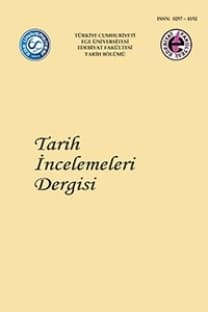Hüsameddin Lâçîn ve Saltanat Dönemi (696-698/1296-1299): Memlûkler’de Meşrutî Bir Sultan Teşebbüsü Ve Akâmeti
Memlûk Saltanatı, Hüsameddin Lâçîn, emîr, nâib, Sultan
Hüsameddin Lâçin and His Sultanate (696-698/1296-1299)
The Mamluk Sultanate, Husameddin Laçin, amir, regent, Sultan,
___
- Abû’l-Farac 1999 Gregory Abû’l-Farac (Bar Hebraeus), Abû’l-Farac Tarihi, I-II, (Çev. Ömer Rıza Doğrul), Türk Tarih Kurumu Yay., Ankara.
- Ağır 2008a A. Mesut Ağır, “Sultan Kalavun Devri Memlûk-İlhanlı Münasebetleri II. Humus Savaşı H. 679/M. 1281”, Akademik Bakış, S. 15, Ekim 2008, s. 1-10.
- Ağır 2008b A. Mesut Ağır, “Memlûklarda Asabiyye”, Muğla Üniversitesi Sosyal Bilimler Enstitüsü Dergisi, S.21 (2009), s. 1-15.
- Akkuş 2011 Fatma Akkuş, “Memlûkler Döneminde Çukurova”, Gazi Üniversitesi Sosyal Bilimler Enstitüsü, (Basılmamış Doktora Tezi), Ankara.
- Ayalon 1951 David Ayalon, “The Wafidiya in the Mamluk Kingdom”, İslamic Culture, XXV, s.89-104.
- Ayalon 1989 David Ayalon, “Memlûk Devletinde Kölelik Sistemi”, (Çev. Samira Kortantamer), Tarih İncelemeleri Dergisi, IV, s.211-247.
- ISSN: 0257-4152
- Yayın Aralığı: 2
- Başlangıç: 1983
- Yayıncı: Prof. Dr. Süleyman Özkan
Geç Ortaçağ İngiliz Toplumunu Anlamak: Tarih Yazıcılığında Bastard Feudalism Kavramının Gelişimi
Erken Cumhuriyet Dönemi ve Sonrasında Türkiye’de Balıkçılık Faaliyetleri (1923-1960)
Konut ve Göç: 19. Yüzyıl Kayseri Rum Evleri
İlkel Kimlik ve Enstrümantal Kimlik
The Institution of “Vigla” in the Aegean Islands during the Ottoman Period
Ayşe KAYAPINAR, M. Halef CEVRİOĞLU
Osmanlıcılıktan Türk Milliyetçiliğine Bir Çocuk Dergisi: Çocuk Dünyası (1913-1914)
HELLENSEVER NERO'NUN BÜYÜK HAMLESİ: ACHAIA EYALETİ'NİN ÖZGÜRLEŞTİRİLMESİ
Kıbrıs Eğitim Tarihinde Önemli Bir Müfettiş: İbrahim Hakkı Bey
